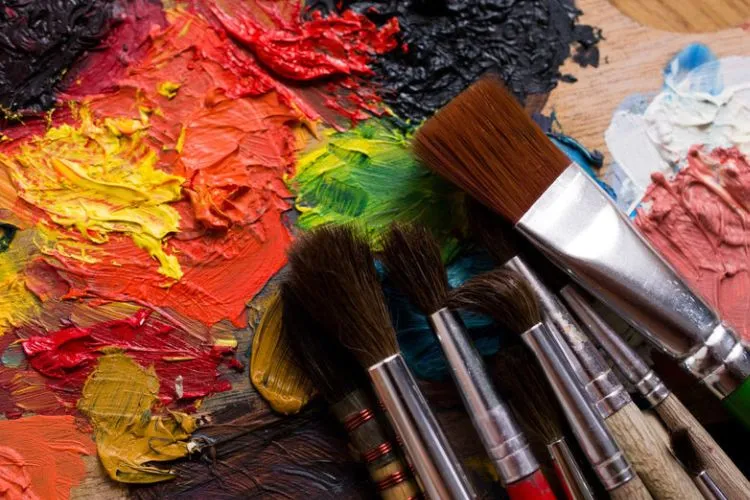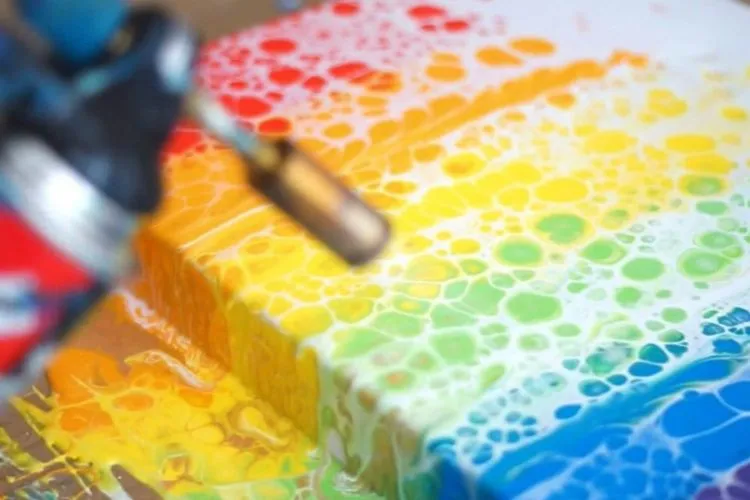In the world of art, acrylic paint is a favored choice for its versatility and vibrant colors. Yet, a question often arises: Does acrylic paint burn?
This guide discusses into this concern, examining the composition, flammability, and necessary precautions surrounding the use of acrylic paint.

Composition of Acrylic Paint
Acrylic paint consists of pigments suspended in an acrylic polymer emulsion. Additives enhance its properties, such as drying time and viscosity.
Understanding these components is the first step in assessing the safety of acrylic paint regarding its flammability.
Does Acrylic Paint Burn?
The flammability of acrylic paint varies between its wet and dry states. In its wet form, its water content makes it hard to ignite.
However, once the paint dries, it becomes more susceptible to catching fire, although it requires a significant heat source to do so.
Chemicals in acrylic paint, such as solvents and additives, may affect its combustion. These components are usually in small amounts and pose minimal risk when handled correctly in well-ventilated areas.
Potential Hazards
Burning acrylic paint can release toxic fumes. These fumes, containing compounds like formaldehyde and acrolein, pose health risks if inhaled. It’s crucial to understand these dangers to avoid unnecessary exposure to harmful chemicals.
Safety Precautions
While acrylic paint is a popular artistic medium, using it safely requires adherence to specific precautions. Primarily, ensure that your workspace is generously ventilated. Adequate airflow is essential in dissipating any potentially toxic fumes released, especially when large quantities of paint are involved.

Also, it’s critical to store and utilize paints away from open flames, sparks, and high-heat devices, as these can increase the risk of ignition, particularly once the paint dries. Tools like space heaters, stoves, or candles should be kept at a safe distance.
Additionally, wearing protective gear such as gloves, masks, and safety glasses can prevent direct contact with the skin and inhaling fumes, especially in poorly ventilated spaces or during prolonged painting sessions.
These simple, yet effective measures can significantly enhance your personal safety and reduce the likelihood of fire hazards or health issues, allowing for a safer painting experience.
Appropriate Disposal of Acrylic Paint
Correct disposal of acrylic paint is important. Do not pour it down the drain, as it can harm the environment. Instead, let unwanted paint dry completely and dispose of it with your regular trash, following any local regulations.
Alternative Uses for Acrylic Paint Remnants
Maximizing every bit of acrylic paint not only fosters creativity but also champions environmental sustainability. Here’s how you can give those leftovers a new purpose:
- Create New Hues: Mix different remnants to discover fresh, unexpected colors that can add unique touches to your artwork.
- Textured Abstract Art: Employ the remnants to produce textured layers in abstract paintings, offering depth and intrigue.
- Customized Stationery: Use them to design handmade cards, bookmarks, or gift tags.
- Decorative Objects: Enhance the appearance of plain objects (e.g., vases, frames) with colorful paint splatters or patterns.
- Fabric Art: With suitable fabric medium, transform remnants into fabric paint for personalized clothing or accessories.
- Educational Tools: A fun way to teach color theory or mixing to beginners.
- Eco-Friendly Practices: Integrating paint remnants into your projects promotes the practice of reusing materials, reducing waste, and supporting sustainability in art.
Through these methods, not only do you enrich your creative expression, but you also take a stand for the environment by minimizing waste.
You may also like to find out: Is Acrylic Paint Mold Resistant? | Is Acrylic Paint Durable Outside?
Regulations and Recommendations
Many regions have guidelines on disposing of and burning paint. These rules aim to protect both public health and the environment. Always check local regulations to ensure compliance when working with acrylic paints.
Best Practices for Using Heat Tools with Acrylic Paints
Utilizing heat tools, such as heat guns or hair dryers, can add impressive effects to acrylic paintings or simply speed up the drying process. However, it’s crucial to adhere to safety practices to ensure both the artwork and the artist’s wellbeing. Here are some guidelines for safely using heat tools with acrylic paints:

- Selecting the Right Tool: Opt for a heat gun designed for crafting, as it offers better control over temperature settings compared to industrial models.
- Understanding Temperature Settings: Start with a low temperature to avoid quick, uneven drying or burning the paint. Gradually increase as needed, without exceeding medium heat to reduce the risk of harmful fumes or fire hazards.
- Maintaining Safe Distances: Keep the heat source at least 6 inches away from the painting surface to ensure even heat distribution and prevent scorching the acrylic paint.
- Moving the Tool Constantly: Avoid focusing the heat in one spot. Instead, move the tool in a sweeping or circular motion for uniform drying and to avoid overheating certain areas.
- Ventilating Your Workspace: Ensure that your workspace is well-ventilated; open windows or use an exhaust fan to disperse fumes that might emanate from heating the paint.
- Watching for Signs of Overheating: Bubbling, discoloration, or a burning smell indicates that the paint is overheating. If these signs appear, immediately remove the heat source and allow the area to cool.
- Wearing Protective Gear: Use heat-resistant gloves to protect your hands from burns and a mask to avoid inhaling any fumes.
- Regular Breaks: If using the heat tool for extended periods, give your artwork—and the tool—a rest to prevent overheating.
Adhering to these practices ensures that you safely achieve the desired effects on your acrylic paintings while preserving the integrity of your art and workspace.
Frequently Asked Questions (FAQs)
What temperatures can acrylic paint withstand before it begins to burn?
Acrylic paint can withstand lower temperatures, but high heat can cause it to ignite. Typically, temperatures above 300 degrees Fahrenheit pose a risk for dried acrylic paint.
Can you use a heat gun on acrylic paint for art purposes?
Yes, but with caution. Keep the heat gun at a safe distance to prevent burning the paint or releasing toxic fumes.
What are the immediate steps you should take if acrylic paint catches fire?
Extinguish the fire with a suitable fire extinguisher and ensure the area is well-ventilated. Seek professional help if necessary.
Is it safe to use acrylic-painted objects near a heat source like a candle?
As a precaution, keep acrylic-painted objects away from direct heat sources to prevent any risk of fire or melting.
Flame Retardant Additives for Acrylic Paints
To further enhance the safety of using acrylic paint, consider incorporating flame retardant additives. These additives are specifically designed to reduce the flammability of the paint, making it safer for use in various applications:
Types of Flame Retardant Additives:
- Halogenated Flame Retardants: These are highly effective at reducing flammability but may release toxic fumes when burned. They are less commonly used due to environmental concerns.
- Non-Halogenated Flame Retardants: These are safer and more environmentally friendly. Examples include phosphorus-based and nitrogen-based flame retardants, which help form a protective char layer when exposed to high temperatures.
- Intumescent Coatings: These coatings expand when exposed to heat, forming an insulating barrier that slows down the spread of flames. They can be mixed with acrylic paint to provide additional fire resistance.
Application of Flame Retardant Additives:
- When adding flame retardant additives to acrylic paint, follow the manufacturer’s instructions carefully to ensure proper mixing and effectiveness.
- Test the modified paint on a small, inconspicuous area to verify its performance and appearance before applying it to larger surfaces.
Heat Resistance in Acrylic Paints
Understanding the heat resistance of acrylic paints can help you make informed decisions about their use in various projects:
Heat Resistance Ratings: Some acrylic paints are formulated to withstand higher temperatures. These heat-resistant paints are often used in industrial settings, automotive applications, and household items exposed to heat.
Common Applications: Heat-resistant acrylic paints are ideal for painting objects like radiators, stoves, and outdoor grills. They can also be used for craft projects involving heat, such as custom-painted mugs or glassware.
Safety Measures: Even with heat-resistant paints, avoid direct contact with open flames or prolonged exposure to high temperatures to prevent potential hazards.
Environmental Impact of Burning Acrylic Paint
Burning acrylic paint not only poses health risks but also has environmental implications. Understanding the environmental impact can encourage responsible use and disposal:
Toxic Emissions: When acrylic paint burns, it releases harmful chemicals into the air, including volatile organic compounds (VOCs) and particulate matter. These emissions contribute to air pollution and can harm wildlife and ecosystems.
Proper Disposal Practices: To minimize environmental impact, avoid burning acrylic paint or allowing it to come into contact with open flames. Follow local regulations for disposing of paint waste, and consider recycling or donating unused paint to reduce waste.
Eco-Friendly Alternatives: For environmentally conscious artists, eco-friendly acrylic paints made with sustainable materials and lower VOC content are available. These paints offer similar performance while reducing environmental harm.
Emergency Response to Acrylic Paint Fires
Knowing how to respond in the event of an acrylic paint fire can prevent injury and damage:
Immediate Actions:
- Extinguish the Fire: Use a fire extinguisher rated for chemical fires to put out the flames. Do not use water, as it can spread the paint and make the fire worse.
- Ventilate the Area: Open windows and doors to allow fresh air to circulate and disperse any toxic fumes.
- Seek Medical Attention: If anyone inhales smoke or fumes, seek medical attention immediately, even if they do not exhibit immediate symptoms.
Fire Safety Equipment:
- Fire Extinguishers: Keep a suitable fire extinguisher readily accessible in your workspace.
- Smoke Alarms: Install smoke alarms to detect fires early and alert occupants.
- Fire Blankets: Have a fire blanket on hand to smother small fires or provide protection during evacuation.
Conclusion:
While acrylic paint does pose some fire risk, particularly when dry, appropriate handling and disposal significantly minimize these dangers. By taking the right precautions, artists and hobbyists can use acrylic paint safely in their projects.

Meet Isabella Anderson, your acrylic painting mentor with over a decade of brush-wielding mastery. Dive into the colorful world of acrylics with her expert guidance, featured exclusively on ‘Acrylic Authority.’ Unleash your inner artist and explore the limitless possibilities of this versatile medium alongside a true acrylic aficionado.
